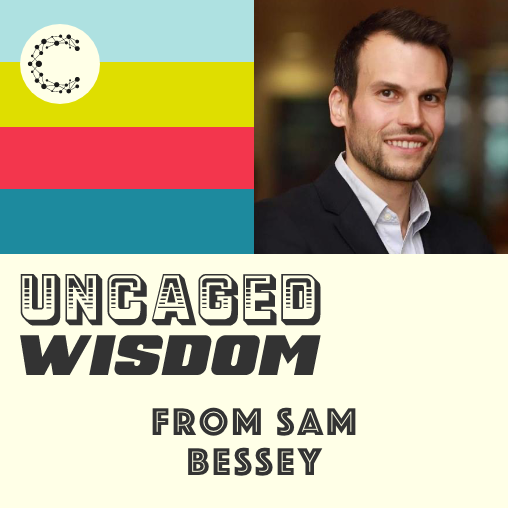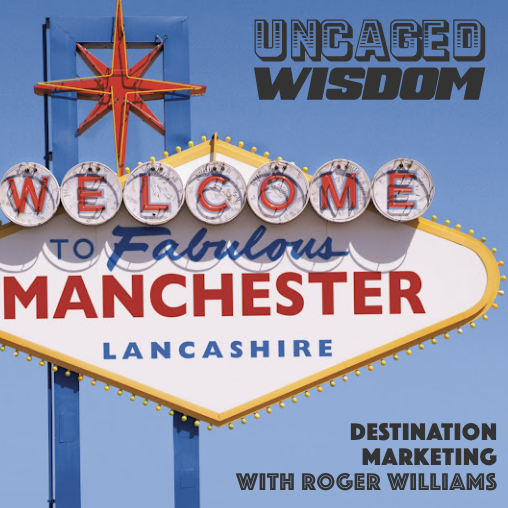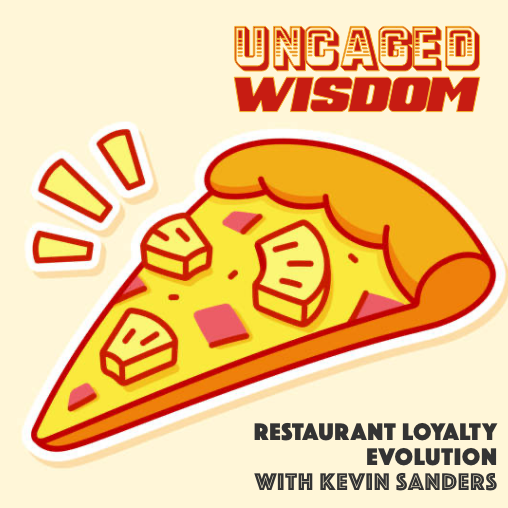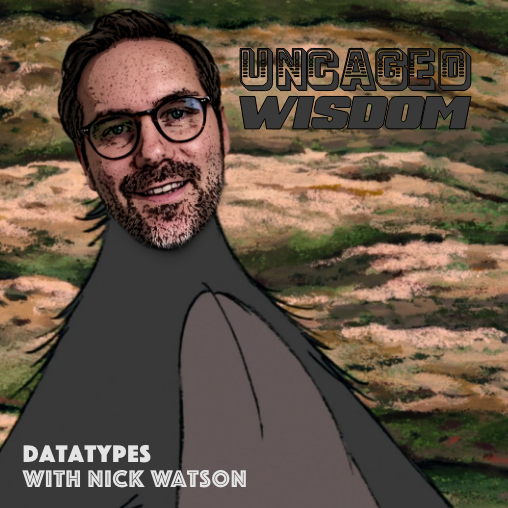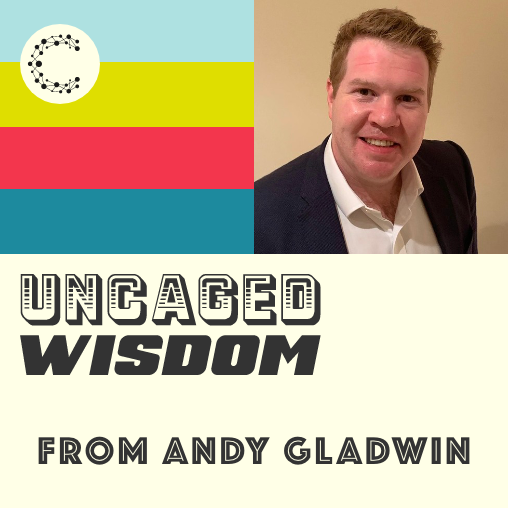A Personalized Perspective of Personalization w/ Sam Bessey
- 0.5
- 1
- 1.25
- 1.5
- 1.75
- 2
Speaker 1: Oh, sorry. Did I get you?
Speaker 2: No, you didn't get me. It's an electric drill. You get me, you kill me.
Speaker 3: I'm not sure if the recording heard that my neighbors decide drilling into a wall and it was really distracting. I don't know if it got picked up or not.
Speaker 4: Uncaged Wisdom, Cheetah Digital's podcast for modern marketing.
Julian Bracey-Davis: Hello, I'm Julian Bracey- Davis, and on this special episode of Uncaged Wisdom, we take another look at the hot topic of personalization. To do so we're joined by Sam Bessey, Director of Enterprise Strategy and Architecture at Cheetah Digital, and soon to be English ex- pat in Australia. Before he shipped off, let's hear what Sam has to say on the matter. Sam, thank you for joining us today. It's very nice to have you.
Sam Bessey: Thank you for having me.
Speaker 7: If you could be in a Guinness Book of World Records, what record you attempt to break?
Sam Bessey: Good question. I imagine it is something down the lines of perhaps one of those... What's that the man versus food guys, something like that. Perhaps we can, how many hot dogs or meat burgers I could do it an hour or something like that. Let's think I have a decent shot at it.
Julian Bracey-Davis: Sam, before we sort of talk about personalization today, I just wondered if you could give us a little bit of a flavor your past and career and some of the journeys and twists and turns you took to getting here today really.
Sam Bessey: Yeah, absolutely. So the last nine years or so have all focused around digital marketing for me. I started off this part of my career at a company called ExactTarget who were acquired by Salesforce in the summer of 2013. And then since then, I've kind of held of a few different roles in the digital marketing space, but most notably and most recently kind of working with real- time decisioning, real- time interaction management solutions. First of all, helping my employee bring those to market in their near region of working with some of our kind of most prominent customers while I was there. So I've kind of built up a bit of a feel, a bit of understanding for that space, kind of what customers are looking for. And ultimately, I think what kind of drives success for clients, and hopefully I can share some of that today.
Julian Bracey-Davis: How did you go down that path? Was it just an interest?
Speaker 2: Yeah, so I think for me like the real aha moment...
Speaker 8: Aha.
Sam Bessey: ...for a couple of things actually that really stand out. One of them was really... When you start to think about the fact that if you kind of approach this whole kind of real- time personalization based from thinking about... Well, actually the way that you think about your customers as a brand and the way you communicate is kind of flipped on its head. It goes from being what I would call inside out. So thinking about, okay, I'm a marketer, I'm going to put together a set of journeys and a set of segments, and I'm going to kind of activate those things together and kind of engage with my customer base. If you start thinking about it the other way around, I'm thinking about it from like what I call the outside- in kind of approach where you're thinking about, okay, I need to listen to all these signals that my customer has given me about their intent, about what they're looking for, about where they are in their journey, what they might be looking for next and use that to kind of drive a real- time experience. It really changes the way you think about customer engagement. So like a real example of that was I was... I've been caught a lot of time working with a CPG brand. And actually, whilst CPG is absolutely looking to get closer to their customers now, the real opportunity for them, and I'll talk more about this later on, is to go from just kind of being someone who is perhaps spinning up a direct to consumer business selling things, to actually be able to help consumers and take them on a journey. So you think about CPGs, consumer packaged goods companies that sell things like coffee machines, coffee pods, or infant nutrition products. There's huge opportunity there to really think about not just selling to that customer, but helping them and taking them on a journey throughout that first year of baby's life or through getting someone to purchase the machine and then sign up to a subscription of coffee pods or whatever it might be. And there's some really interesting nuances in how you can do that, and how you can kind of understand the customer to take them on that journey at wherever point they're on out, wherever it is you want to get them to. Yeah. And secondly, as an organization, you can kind of learn so much about how you kind of going to market, how you're taking your products forward and how you're kind of using all that data to drive a better customer experience.
Speaker 7: So as you've worked with different vendors, and you're working with some of these brands, what are you seeing for a definition for personalization that you're able to define for each of them?
Sam Bessey: Yeah, what I always say is that personalization itself is quite a nebulous concept. It's very broad, and it can be quite confusing as well as a brand who is looking to build a personalization strategy. Right? I mean, if you just go and look at the research that's done by the likes of Gartner and Forrester Wave, there's about four different reports that they publish on a kind of like a regular cadence. They have one called the journey orchestration platforms report, and a real- time interaction management, experienced organization, and the magic quadrant for personalization engines, right? So immediately you've got kind of four different takes on what it might, what personalization is there. But I think very simply you can boil it down to there being... I guess it's three different kinds. And you have within that kind of action and management, so kind of trying to move the customer along or opt a certain behavior like, buy this thing, sign up for this, fill out this form to sign up for an account, whatever it might be. Recommendations or suggestions, which is very much about the kind of like the Netflix, or the Amazon approach, where you're kind of positioning skews, and products, or movies, or articles, or something like that. You're essentially trying to sell or recommend something to to help the customer. And then there's orchestration, which is essentially curating or managing an experienced across channels as a result of customer behavior. So I think within that, first of all, it's important as a brand to really kind of break down and understand the market a little bit and think about what you as a brand are kind of looking to tease. Actually what is the experience we want to drive? And then looking at perhaps how these three different kinds of personalization tactics might play into that. And from there, of course, there's then a whole range of the vendors that offer different kind of flavors, and kind of mix and match these different capabilities together. And I think all three are really important in actually building a kind of successful customization strategy. But I think for brands, first of all, it's important just to understand that kind of make it to the market and kind of what's there.
Julian Bracey-Davis: The three you listed there, that's a nice, clear, three tactics that people can get their heads around. But then, it is a mixture of those three, would you say?
Sam Bessey: Absolutely. Yeah. So for example, if you are a retailer that sells, I guess we'll be pointed here in the UK fast fashion. Yeah. Things like recommendations and suggestions at a product level are probably going to be quite a big component of your personalization strategy, along with kind of orchestration experience. However, if you've got a bank or if you are someone or a retailer who sells kind of very high value products that someone might buy in once in a lifetime like engagement rings and things like that, or very high- end jewelry, then you're more likely to think about kind of friction and offer management as being that kind of key enabler within personalization, right? Because if you think about what you're trying to do, if you're trying to move the customer along the journey, which might take them kind of on many touch points where they start on the web and they have a chat with a real person and up in store for a fitting, whatever it might be. So that's going to require a very different set of behaviors from your customer in order to drive the outcome that you're looking for as a business.
Speaker 7: You kind of touched on a little bit earlier around the customer journeys, so how should personalization kind of be incorporated into that across the funnel?
Sam Bessey: I think it's really important that personalization really sits across in kind of all areas that have that kind of sales funnel. I think one thing that you kind of see quite often, it's that organization have start thinking about this in... it goes like the middle of the funnel, as I would call it. So when someone has already been acquired and when you're looking to essentially, I suppose, to sell up something, that's quite often where these kinds of things come in. And they can be quite tactical, things like making a recommendation of a product or showing of honest... kind of get someone to kind of inaudible gets this complete. I think one thing that brands need to really bear in mind, and where we... I've really seen success in my time doing this is that yes, that's absolutely important. It's a great place to start, but it's definitely not the only place to kind of look for this kind of thing. And really, personalization is something that's just set across every single step of the customer's journey, right from that first acquisition point where perhaps they click on an ad, or where they land on your site for Google, or they walk into a store, or whatever it might be. And the really important thing is that, here, we're not just talking about the funnel- less and the online sales funnel, this equally applies in any channel that you might exist as a brand. So right through from that kind of first point where your customer first has contact with you as a brand, right through kind of awareness, and kind of education, and onboarding, and purchase, and post- purchase, and advocacy prep rights through to things like renewal, suppress five years down the line or something like that. And obviously, this applies differently depending on the kind of industry and the kind of use case you have as a brand. But I just think it's really important that this is applied to every single stage. And it's those brands that do that well that see success. And this kind of takes me on to something else as well, which I think is really key. And that's to make sure that this is not just a function of marketing. Quite often, it's something that starts in marketing or is owned by marketing, but in order to do this really well, it's really important that brands start to think about how you bring the service team into this, or the kind of in- store, kind of brand who is into this, or the web team into this, or the advertising team, whatever it might be. It's really important to get this personalization as a project and as concept happening at an organizational level and not at a departmental level.
Julian Bracey-Davis: I know we've already sort of touched on this a little bit, but maybe we could just... It's another good excuse for us to break down your thoughts on that further, but you mentioned, yeah, the outside- in approach and you gave us a quick sort of description of that. Maybe we could just take this time to dive a little bit deeper on that.
Sam Bessey: Well, it's not actually outside- in. What I'm referring to is really not basing your customer engagement all year as a brand, supposing what the customer is looking for and kind of putting the journeys, split into segments, and then they are deploying those kind of sort of campaigns, but really listening to customer engagement and using that as the basis for everything you do. So essentially that's all about having the mechanism to be able to pick up on these signals of intent and signals of kind of customer behavior, and then use those in real- time or near real- time, deliver some kind of experience, whether that be back to the same channel, or actually it comes through a different channel. And just to expand on that a little bit, search for brands can often sound like something that is kind of quite scary to embark on or something that is kind of quite inaudible because it needs loads of data, loads of integration, loads of extensive work with the IT team or an Excel consultants to put all these mechanisms in place to ingest this data, but it doesn't have to be. There's a lot that you can do with really not that much data. And I think a really important thing to say here is that it's not just about listening to what the customer is doing and it being you're observing their behavior. That's definitely important, and it's definitely one of the... I'd say one of the kind of keystones of a good kind of data strategy, but it's also about knowing when to ask the customer a question as well, sort of intervene and say something like perhaps pop up question on a web form or send them an email that's got something in it. But what is really important here is doing it at the moment where you feel they've reached this kind of point where you need to learn more about them to help them, or where they are kind of reached a fork, a few like crossroads in that journey. So I'm giving you a purchase example of that. Let's suppose that you are like a bank or something like that, and you've got a website where customers are coming on and they're looking across a range of products like overdrafts, credit cards, and loans. So what you're seeing then, just from this customer just who you don't know was just coming on sort of browse is that they've got an intent and need around borrowing, but you don't know what they're really looking for yet. And it's that they might not know either. So you might get two types of customer, one that go straight down to the personal loan section, and goes and fills out an application form, puts exactly what we want, and there you go. You have one kind of engagement strategy, customers like that, they're very clear on what they want. They know they need a loan for a X amount and that's that. But then you get the kind who we'll kind of look across, as I said, overdrafts loans, credit cards. They won't make a decision on any of those things. They might go away and go to a competitor. They might not do anything. They might reach out to your sort of service desk or something like that. Before they get to that point, or when they're at that point, there is the opportunity there for the brands to pick up on that need on the fact they are looking at products that are under that umbrella of borrowing, but they're not sure what to do, right? So as a brand, you can then reach out and say, hey, it looks like you've got a borrowing need. Can we help you with this? And that can be either through something that's put back out onto the webpage and you're taking them through a step- by- step wizard to help them find the best thing for them. It could be through an email and you've got information. It could be through a pop- up chat where they can then talk to a live agent. So really driving that kind of outside- in approach to the way that you engage is the way that brands are really successful with this stuff. And in fact, again, to kind of quote what comes out some of the kind of industry stats around this. And there's a stat by Gartner that talks about the fact that grants that do this kind of help me personalization that actually recognize and listen, and then do something to actually reach back out to their customers, have a plus 16% change in mutual commercial benefit, versus just trying to sell someone something, or just putting product up because they sort of product retargeting them, which has a minus 4% kind of change from the same index. So the difference there being 20% between they're kind of recognizing and helping versus just recognizing and then just showing them what they've already seen.
Speaker 7: So when we're talking about this piece around acquiring the inaudible customers for brands that are just meeting customers for the first time and we're trying to build up that preference center on their profiles, what are some types of questions that they should be asking those inaudible?
Sam Bessey: Yeah, that's a really good question. The best way of tackling something like this is the first tool as a brand. Think about what is the actual objective that we are kind of moving towards with personalization. What is the thing that we're trying to do? I mean, clearly when you start a personalization strategy, you have to have a KPI, or an objective, or something that you could measure and see improvement on. So if we kind of go back to our banking example, it might be that you want more people to go sort in that first stage of a finance application, or you want more people to sign up to some kind of newsletter or some kind of process or something like that. So in that case, I think knowing that that's your objective, that really informs the kind of information that you should be asking for upfront. Like I said, I think what's important is that you don't actually need that much to do this stuff well. So I think, first of all, establishing customer identity is really important, particularly as we start to look in the direction we're going with this inaudible world. The fact that Google, Apple and the rest are putting more and more constraints on how we use cookies. I think, first of all, getting something that allows you to identify that individual is really important. And then secondly, what I would say is more than the specific data points is probably more about the way that you actually present those things to the customer. And by that, what I mean is kind of breaking it down into kind of smaller hurdles for them to kind of have to go over in order to kind of get to where you want them to be. Quite often, as you go and start presenting or requiring large amounts of data upfront from customers, that where you really start to lose people. And actually just doing enough to get them to the next stage, and then moving them kind of forward again, sort of step one, two, three, four is usually the way the brands see success. So if it's something like getting someone to that state where they do fill out that application form, or they do fill out that lead capture form, whatever it might be. Then it's just building a data asset that's just about big enough for that and nothing more. And really thinking about when you actually put those asks in front of the customer. And like I said, crucially, how much of that ask you point for that customer at any one time?
Julian Bracey-Davis: Next section, really just want to... perhaps even double down on looking after a brand marketer listening to this, trying to really work out what they're going to do next. To start off, you need to make sure that there is a data layer, right? There is a customer identify. There is something to build something on. We've also understood how we can potentially activate the data. Final bit is trying to work out what the goals of the brand. As a marketer, will they help to have that data layer or they'll have information that could become a data layer. They just may lack the idea of making it a customer identify, or maybe it's that they have all that but they didn't know how to action or have the tools to action. How do they approach practically doing this?
Sam Bessey: It's definitely something that I think is a struggle for a lot of brands. And I think the answer is that, first of all, a lot of brands do have a lot of data on their customers already. In fact, they have far more than they do need to actually be able to do really good at personalization. And what they actually often lack though is the ability to actually pull that together in a cohesive way that facilitates good personalization. And part of the reason for that is number one, it's disparate systems. And number two those disparate systems have disparate owners across the business quite often. And the first thing, and I think you kind of touched on it there really, is to kind of build this kind of foundational layer that allows you to actually activate customer data. And for me, it kind of falls into two buckets. You kind of get the stuff that lives internally in the organizations already that you really want to be able to leverage, right? And that will sit across all kinds of systems and all kinds of departments. And there has to be some kind of efforts. And again, we talked earlier on about how press presentation is a project owned by marketing, but involves the whole business. This is an example of exactly that, right? That kind of operational, kind of underpinning that allows teams to come together and actually get that kind of data that sits across those various assets into a single place where it can be used. And that forms, I suppose, what I would call that a slow moving kind of data asset. You've got data from across your organization. It's things like perhaps stats on how many minutes a month someone's using of their phone contract, or how much they got in terms of points in their loyalty system or whatever it might be. And then on top of that, you've got another layer, which is more your kind of like hot data story, your customer, your faster moving data. And that's really something that, again, like especially as vendor, kind of come to the market and we'll give you as part of the ability to be able to do that listening. So it's all about taking an insights from what that customer is doing in channel, and then using that to actually then drive an experience. And the real key is actually having those two things kind of come together to actually give you the ability to say, right, I know the customer is here and this is their intent, because I can see right now they just visited this page, or they've just walked in store, or swipe the loyalty card, or whatever it is. And actually I know because of all the data inside the organization, that this is their historical spend, this is their historical points balanced, and therefore, using those two things together, I can make a decision and put this thing in front of them because it's the best action for the customer. That's kind of what we built here with EDP at Cheetah, the ability to actually start to bring these two kinds of data together and have that consolidated data asset at your disposal. Then, as a marketing team, you can use to launch these personalized experiences.
Julian Bracey-Davis: Because we got that data in the right place, in the right environment, in the same house, we love a house analogy on this book, because that's when it can then be actioned in that native system. Right? And that's where we can start thinking about the tactics you talked about at the beginning of the session, right? The inaudible and the three we discussed. We've got the information, then we can work out potentially, which of the best tactics to use. Is that a good step next?
Sam Bessey: I guess there's two things there really tactics in terms of things like, what are we actually going to do from a personalization perspective? What are the the different experiences we want to drive? And that I guess can come through either as journeys, putting people into kind of relevant engagement journeys based on their behavior, based on their intent, based on what they've done. It could also be about bringing things like experiences into it as well. So we talked earlier about the idea of asking people questions, or kind of getting more information from them at the right moment. That is something that we can absolutely do using the experiences platform, actually surface those and ensure that we're collecting just our own math data at just at the right time. And then finally, actually, putting content back out in channel. So in real- time delivering some kind of messaging, some kind of help, some kind of recommendation that is aligned to what that customer is doing now. But you're right. Once you've got that data in place, you then the ability to start to execute on these tactics.
Julian Bracey-Davis: Do we need to put the fort around what we're trying to do at the front of those two pieces? Or actually do we need to get our house in order to start off with before we ask the question?
Sam Bessey: It's a bit chicken and egg, right? So I guess there's kind of two halves to it. So absolutely. Yeah. You touched on something really important there. And I think it's inaudible two things, two threads that run in parallel. It's about having operational excellence, right? So we touched on this earlier on. We're involving lots of part of the business here. So organizations would do well to kind of form a steering committee or a team that is not just there to deliver the project, but it really there to think about this kind of holistically on an ongoing basis. You have representatives from different parts of the business that represents service, sales, and marketing and so on, but also people that represent things like content and the web as well, because they're really important components when it comes to actually delivering an experience. So having that kind of steering committee. And then really thinking as you want to just do that about what is it we actually are trying to do. And for me, I always talked to customers about starting with what I called call-ins in a use cases. So by that, I mean, how many use cases which traversed is lots of channels at once, which is the Thomas of it. But you're only trying to hit on something that's kind of quite tangible and quite kind of well- defined, which is, I guess the skinny part to start with. So an example of not doing that would be going, right, okay, we're going to start putting personalization on the homepage and on all our product pages. But it's like, well, okay, that's fine. You might drive some incremental revenue because of that. The recommendations you've got on, the actions might drive people towards the kind of behaviors that you want. But number one, can you measure all those different things that you're moving the needle on, and number two, and really critically, how do you know that what you're actually negatively impacting when you start doing that, if you're not defining the use case really tightly to start with? So if you're trying to drive more people to sign up to the loyalty clubs through lots of next best actions and things like that all over the site, you need to actually make sure you understand what is the impact of doing that on average revenue plus average order value, or average number of impressions per visit, or something like that. Great. You've got someone to do the thing you wanted them to do, but actually, what have I kind of negatively impacted by doing that? And by having any of these tall and skinny use cases, and well- defining the outcome that you want, you start to be able to really do that. See, here's the KPI, and I want to move the needle on. Here's the thing I want people to do. This is what I'm going to measure as a result of that. And then, because you've put up one use case, if you'd start to see declines perhaps in other areas, like actually it's having an impact on number of people who's signing up for my email list or the number of impressions per visit or wherever it might be. It then is much easier to kind of measure that as part of something that you've kind of part inaudible as use case rather than just applying personalization everywhere. And then just a note on the Thomas as well, quite often, I advise customers to start with channels that they own and channels that are easy to kind of work with, I suppose, which is typically things like digital marketing, the web and ad segments. So customers that look at things like, for example, putting next best actions into CRM for customer service, or look to doing it into ecosystems and things like that, the problem with those channels is that quite often then the kind of technical end of it is not owned by the brand itself. And quite often, it's going to require some retraining of sales folk or folks who work in the retail stores, whatever it might be. And they can actually be quite detrimental to customer experience well at the end of the day, because suddenly you've got something new that the agents got to do, you've increased the full handling time, someone inadvertently said something that's freaked the customer out because there's always new data. So those kinds of channels have to be managed very carefully. So yeah, I mean, my takeaway from that, my very long answer to your short question would be look at digital channels and look at a tall and skinny use case and very carefully define what you're trying to measure and what you may or may not be impacting as a result of the thing that you're doing.
Speaker 7: So Sam, it'd be great to hear just another quick example of the Thomas getting use cases for us to be able to understand it a little bit more from maybe the retail perspective.
Sam Bessey: One of the things we see a lot in retail, I think particular at the moment as we're kind of moving towards cookie becoming having a less important role in the web and so on, is retailers wanting to grab something about a customer like have them create an account or give their email address or sign up for the loyalty club or something as soon as possible in that kind of customer journey. So again you as a brand may want to construct a use case around that as part of your personalization. So for example, someone coming to the homepage, browsing some products, and then getting to a certain kind of inflection point in that journey where right now we're going to... We want to talk about the Lord's club now where the benefits of signing up for emails, whatever it might be. So really kind of building a plan to get around that might be where you're going from a personalization perspective. It might be the thing that you kind of base your personalization use case around, but it's really important as doing part of that to kind of measure the impact on things like average order value or the impact on number of pages that are actually browsed as part of a session, either before or after that kind of point that you have to the journey. Because what you might find as a brand is even though you're getting more of those email addresses and people are actually signing up, you're increasing your email database size, you're having a negative impact in terms of actually how many products they looked at during a session or the average amount of time on site or something like that. And as the brand, you need to make sure that you're actually positively impacting, or at least not negatively impacting both those metrics. Right? So having both perhaps multiple strategies that you're going to... or multiple tactics, you're going to apply to that overall goal and being really clear on what you're measuring is really important as part of actually building up that particular personalization use case.
Julian Bracey-Davis: Lots to consider for any brand marketer or looking into personalization to get their head around. Certainly what you're trying to get at here is the fact that it shouldn't be in daunting tasks. They should try and move the needle a little bit.
Sam Bessey: So, it's all about having like a single objective, your kind of moving towards as a business, it's about having a KPI or a set of KPIs you've defined upfront in terms of what you're actually trying to move the needle on. And by kind of focusing the mind like that, it also allows you to think about things like what data you needed to be collecting and what specific experience you need to be driving in quite a focused way, rather than taking this kind of static and approach.
Julian Bracey-Davis: So I'm just to close out though, but I just wondered if you could elaborate on, yeah, some of your thoughts on the good and bad of personalization and perhaps, yeah, that piece around when a brand should be an advisor, and how that helps move the dial versus when they actually should go for the sell.
Sam Bessey: Yes. So this is something that I talked about a lot to clients I was working with in areas like CPG and financial services in particular, because obviously you'd have to be very sensitive of your customer's needs and you don't want to be doing the selling when actually they really just want some help, and perhaps sometimes they're quite distressed in some ways. So the first thing I'd say on that is that it all comes back to the thing that we've talked about all the way through, which is having a good data strategy. So having your house in order around the data that you're collecting, and what data you have in your customers, and also ensuring that you have the right degree of what I would call business context in your personalization solutions. So understanding what it means when a customer is at a certain point on your site or in the experience they're having with your brand in the app or whatever it is, kind of understanding that and understanding what that means in the context of how that customer is behaving overall. So if we were to take a brand that was doing something like infant nutrition, for example. If someone is on the page about kind of problems with their baby, keeping the formula down or something for the first time, probably not a good moment to be going and trying to sell them more formula, whether or not it'd be a customer of yours in the past, right? But maybe a good time to start to actually put some kind of experience in there that could lead them towards looking at articles that talk about different feeding techniques or articles that talk about different products that the brand offer that may be able to help with that, but not doing it in a kind of selling way, but doing it in, would you like some help with this kind of way? And I guess there's something top of mind for me and at the moment, particularly kind of going through this as a parent. But I remember very vivid, kind of example of working on a brand in that kind of area that was having those kinds of challenges. And you can imagine this applies equally to things like financial services as well, where we talked earlier about people looking for credit. I guess it's important to perhaps also understand why they're doing that, pick up on those signals, and understand whether you need to be selling them a credit card, or whether you need to be kind of advising that they speak to someone on the team about their borrowing needs, because obviously there could be some distress behind that.
Julian Bracey-Davis: It's personalization heading in the right direction, just generally where technologies and brands are trying to go, trying to move it towards helping an individual customer make the right decisions that are useful to them rather than trying to be everything to everyone or get hyper- personalized or to on the nose. Do you think it's you think the industry is in a good place?
Sam Bessey: I think so. Yeah. I mean, I think we've kind of gone through this stage where we've kind of been, I guess, as an industry and perhaps even as brands kind of immature about it. And we've kind of moved on now to really start to think about how we use this technology for good. And I think that realization that it's about knowing when to help people and knowing when to kind of sell and using those two things together, have kind of really a base under that in terms of this whole space moving in the right direction. And if you look at what is offered by ourselves and teach digital by the market, and you think about those kind of three different kinds of personalization solutions we talked about at the start. So offer management recommendations and orchestration. I think what's really important in that area is blending the three things together in order to come up with the strategy that works for you and for your brand. So yeah, I would say it absolutely has moved in the right direction. And I think the thinking is much more mature and established in terms of helping us do that both as vendors, but also for brands who are buying these solutions and this software and these... the services around it as well.
Speaker 7: We always like to close out our show with a piece of uncaged wisdom. So this can be related to your job. It can be related to professional personal life.
Sam Bessey: Yeah. I mean, I just really like to go back to something I said earlier on really. If you're a brand that's thinking about doing this, or you're kind of embarking on this journey, to me, it's really important that brands don't just think about it as a function of marketing, and they really start to think about this more at an organizational level. And nearly every single instance I've seen of a customer, do I have a brand doing these things well and be successful? So I thought about it in that way. It's getting out of that silo and just thinking about the whole customer experience and the whole brand and how this becomes an effort that everyone is trying to giving input to I've worked.
Speaker 7: All right, well thanks, Sam. That was great.
Sam Bessey: It's great. Thank you for having me.
Speaker 4: Subscribed to Uncaged Wisdom for the latest and greatest in digital marketing insights and how they're solving problems with software and strategies.
DESCRIPTION
This week, Sam Bessey joins the show! Sam is the Director of Enterprise Strategy and Architecture at Cheetah Digital, and has been focusing on Digital Marketing for the last, almost, 10 years. Today he is here to discuss personalization, including breaking down the three components of personalization and how it applies to all parts of the business. Tune in now and hear Sam talk about some of the difficulties in personalization that marketers run in to, and insights that may help you build a stronger strategy.
Today's Guests


